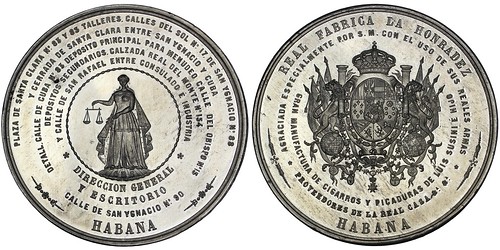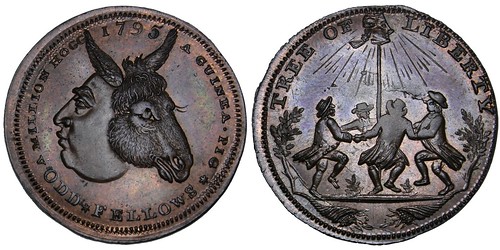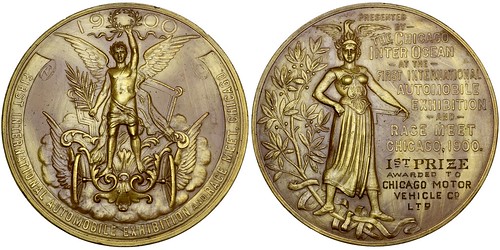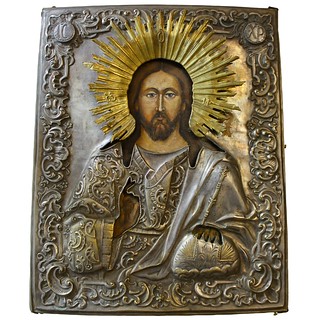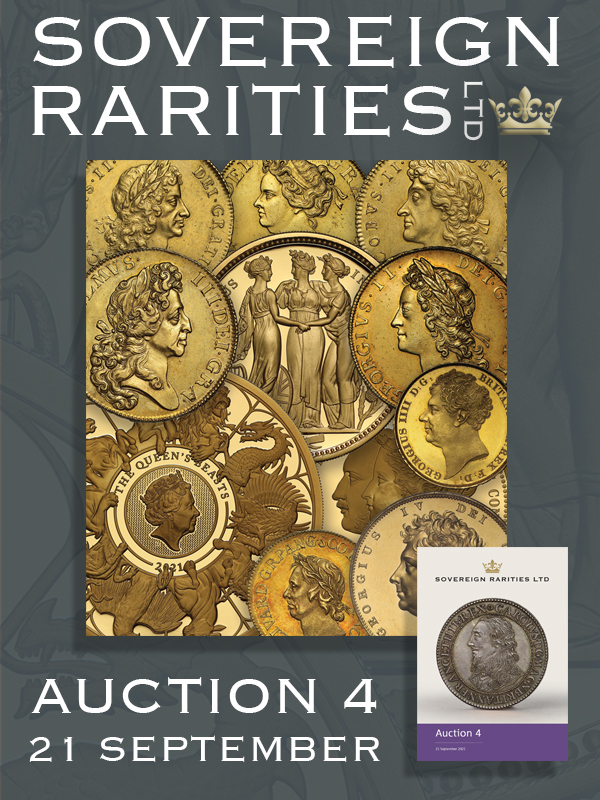
PREV ARTICLE
NEXT ARTICLE
FULL ISSUE
PREV FULL ISSUE
NUMISMAGRAM SELECTIONS: SEPTEMBER 2021Jeremy Bostwick at Numismagram forwarded these highlights from his most recent upload of medallic art to his website. In addition to his usual selection of world art medals and plaques, there are four Russian icons that continue in the vein of attractive and artistic pieces–one of which is included in the highlights below. For all of his new items, please visit numismagram.com/inventory. -Editor 101766 | CUBA. Honradez Royal Tobacco Factory tin Medal. Issued circa 1859 (57mm, 87.60 g, 12h). PLAZA DE SANTA CLARA No 83 Y 85 TALLERES, CALLES DEL SOL No 17, DE SAN YGNACIO No 88 / Y CERRADA DE SANTA CLARA ENTRE SAN YGNACIO Y CUBA / DETALL, CALLE DE CUBA No 83 DE POSITO PRINCIPAL PARA MENUDEO CALLE DEL OBISPO No 15 / DEPOSITOS SECUNDARIOS, CALZADA REAL DEL MONTE No 154 / Y CALLE DE SAN RAFAEL ENTRE CONSULADO É INDUSTRIA / DIRECCION GENERAL / Y ESCRITORIO / CALLE DE SAN YGNACIO No 90 / HABANA, female personification of Justice standing facing, holding scales / REAL FABRICA LA HONRADEZ / AGRACIADA ESPECIALMENTE POR S. M. CON EL USO DE SUS REALES ARMAS / GRAN MANUFACTURA DE CIGARROS Y PICADURAS DE LUIS SUSINI É HIJO / PROVEEDORES DE LA REAL CASA &a. &a. / HABANA, complex Cuban coat-of-arms. Edge: Plain. Choice Mint State. Highly brilliant and reflective, with just a few lightly scattered marks preventing gem status. $295. Cuban cigars have long been the standard bearer of a fine tobacco product, and Don Luis Susini's royal factory in Havana sought to keep that high standard through not just the firm's name (la honradez meaning "honesty" or "integrity"), but also through what was, at the time, revolutionary packaging.Counterfeiting was commonplace and copyright protection was virtually non-existent, so Susini turned to packaging in order differentiate himself from fraudulent products, with the firm using color lithography to produce some of the world's first colored labels. A wordy yet intricate design. -Editor
To read the complete item description, see:
101778 | GREAT BRITAIN. Middlesex Spence's Copper Halfpenny Token. Issued 1795 (29mm, 12.14 g, 6h). A MILLION HOGG | A GUINEA • PIG / ODD * FELLOWS *, janiform head composed of King George III and an ass / TREE OF LIBERTY, four men clasping hands and dancing around pike surmounted by head of George III; branch to left and right, two cornuacopiae below. Edge: Plain. D&H 797a. Choice Mint State. Charming chocolate brown surfaces, with some alluring brilliance remaining. A popular and highly provocative satirical type. $345. This type plays upon sentiments of the time–mostly revolving around the French Revolution, the rise of Napoleon, and Britain's increased spending to form a European coalition to fight back the eventual dictator. The head of the king is obvious, and does not downplay his rotund features, while the head of the ass is more indirect. It can be seen as William Pitt the Younger, Prime Minister and the one calling for the increased taxation to fight against Napoleon. The ass can also be interpreted as the British citizenry itself, as it was they, through parliament, that caused Pitt to be in that position. The "million hogg" was to point fun at the king, for his allowance of seemingly everything to be taxed, while the "guinea pig" was a pointed allusion to one such tax—the "hair powder tax." A tax of one guinea per year was applied to hair powder for wigs, with those initially agreeing to such a tax being the guinea pigs. Meanwhile, the reverse alludes to the beheadings in France, with Britain's own monarch drawing the ire of the token maker instead. A classic piece. -Editor
To read the complete item description, see:
101751 | UNITED STATES. Chicago, Illinois. Automobile gilt bronze Award Medal. Issued and engraved on 25 September 1900 to the Chicago Motor Vehicle Co. for first prize (63mm, 172.62 g, 12h). By Hyman, Berg & Co. Seminude male, holding garlanded wreath and palm frond, standing facing on winged "horseless carriage" among the clouds; on banner around, FIRST INTERNATIONAL AUTOMOBILE EXHIBITION AND RACE MEET, CHICAGO / Female personification of Chicago—the "I Will" woman—standing facing, with hand on hip; garlanded laurel branch curved to left; PRESENTED / BY / THE CHICAGO / INTER OCEAN / AT THE / FIRST INTERNATIONAL / AUTOMOBILE / EXHIBITION / AND / RACE MEET / CHICAGO, 1900 / "1ST PRIZE / AWARDED TO / CHICAGO MOTOR / VEHICLE CO / LTD." Edge: "FOR BRAKE, SEATING 6 PASSs RUN 3 MILES. TIME 10 M. 31 Sec." HYMAN, BERG & CO. Choice Mint State. Vibrant yellow-bronze allure, with a somewhat two-toned, swirled nature. A very rare and interesting medal from the dawn of the automotive era. Very thick rims, with edge dimensions measuring 8mm. $1595. As the world moved into the era of "horseless carriages," exhibitions on the latest in advancements became a must for both engineer and aficionado alike. The first such international exhibition in Chicago was held in September 1900 and under the auspices of the Chicago Inter-Ocean, a local newspaper. Numerous events were held to test the various entries, all of which were meant to test ingenuity and skill, with the hope of discovering the very best in technology. The event for which this award was presented occurred on 25 September 1900, the last day of the expo (which had already been extended two days on account of inclement weather). According to the recap from the following day's issue of the Inter-Ocean, this prize was not without controversy: "The next event was a three-mile race for motor vehicles seating four or more grown people. The Chicago Motor Vehicle company entered in this event a motor vehicle with a nine-passenger break body. The St. Louis Motor Carriage company entered a regulation carriage, built to seat but two people. To this was attached an additional seat by straps. The judges, not aware that the seat was simply attached, and not part of the vehicle, allowed the wagon to show. The conditions being unequal as to weight and seating capacity, the St. Louis machine won. A formal protest has been entered by the Chicago Motor Vehicle company, and the judges are to reconsider the contest." The paper later goes on to clarify the verdict: "Fourth Event—Three-mile race for motor vehicles carrying four people. Won by Chicago Motor Vehicle company. Time, 10:31. St. Louis Motor Carriage company vehicle entered, but disqualified because rig was not according to specifications." The reverse of this medal features a then recently adapted female personification for the city of Chicago, the "I Will" woman—so-called because of the "I Will" on her breastplate. Featuring a resolute stance and a phoenix rising from the ashes upon her head, she was designed by Charles Holloway in 1892 and meant to present the city's resilience following the Great Fire. Holloway won a contest supported by the Inter-Ocean and judged, at least in part, by the great illustrator Thomas Nast. Interestingly enough, Holloway was an artist well known to Chicagoans, though he was a graduate of the St. Louis Art School, furthering the Chicago/St. Louis connection for this unique award medal.
Elaborate design. Cool item. -Editor
To read the complete item description, see:
101783 | RUSSIA. "Jesus Christ, Pantokrator" wooden Icon. Made circa 1870-1890 (220mm x 270mm, ~700 g). Silver and gilt oklad: Image of Jesus Christ–elaborately draped, with radiant nimbus crown, holding orb and scepter, and raising hand in benediction; openings revealing his head, neck, and hands, all of which are painted in tempera atop wood; elaborate scrollwork around, with medallions to upper left and right reading IC – XC. Back and sides: Wood exposed, with the oklad hammered into the wood on each side; a prayer has been written across the back in fourteen lines, some of which has begun to fade. Extremely Fine. Light gilt appearance to the oklad on the nimbus crown, with more of a gunmetal gray nature to the remainder; incredible detail overall, and a large, majestic, and moving piece of art. $895. Following the conversion of the peoples of the Ancient Rus' (those in the eastern and northern portions of Europe) to Orthodox Christianity in the late 10th century, queues were taken from Byzantine art and iconography. As time progressed, and given the lack of more personal representations of religion, the practice in the emerging tsardom of Russia began to emulate the artistic traditions in western Europe within the Protestant and Catholic spheres. Thus, the Russian icon was born—a representation of one's religion and hopes, all in the form of a small-scale, craft-oriented image, usually done on wood and with the ability to venerate in one's house. The imagery would usually focus upon Christ or the Theotokos (the Virgin Mary), but could vary widely to other lesser-encountered saints and passages, even to those more native to the Orthodox church in the Russian dominion. The various images would generally be painted in tempera, a type of paint mixed with egg, and featured a gilt-infused background in order to elevate the flair and magnificence. Later additions to the practice would include a "protective" layer made out of tin, bronze, or silver known as an "oklad" or "riza," allowing both the image beneath to be somewhat protected along with the oklad itself to be further adorned and embellished by the silversmith–adding to the majesty and dazzling nature of the icon. The image of Jesus that has become known as "Christ Pantokrator" dates to 6th or 7th century, with the first numismatic representation of Christ following shortly thereafter during the first reign of Byzantine emperor Justinian II in 685-695. In the iconography, Christ is portrayed with a subtly dual-natured face, with one side slightly calm and human, and the other slightly stern and devine. Meanwhile, he makes the benedicting gesture with one hand, while holding the Gospels in the other. The name of the imagery itself–pantokrator–emanates from the Greek, meaning the "all-powerful" or "omnipotent." It, and all of its derivations, is one of the most iconic pieces of imagery within Eastern Orthodoxy. Unusual item. -Editor
To read the complete item description, see:
Wayne Homren, Editor The Numismatic Bibliomania Society is a non-profit organization promoting numismatic literature. See our web site at coinbooks.org. To submit items for publication in The E-Sylum, write to the Editor at this address: whomren@gmail.com To subscribe go to: https://my.binhost.com/lists/listinfo/esylum All Rights Reserved. NBS Home Page Contact the NBS webmaster 
|
